电子科技大学:《材料设计与计算 Materials Design and Computation》课程教学资源(课件讲稿)MDC 04 DFT(3/3)
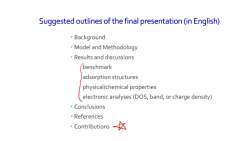
Suggested outlines of the final presentation(in English) ·Background Model and Methodology Results and discussions benchmark adsorption structures physical/chemical properties electronic analyses(DOS,band,or charge density) ·Conclusions 。References ·Contributions达
Suggested outlines of the final presentation (in English) Background Model and Methodology Results and discussions benchmark adsorption structures physical/chemical properties electronic analyses (DOS, band, or charge density) Conclusions References Contributions
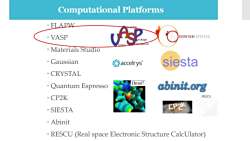
Computational Platforms ·FLAPW ·VASP QUANTUMESPRESSO ienna Materials Studio Gaussian accelrys' siesta CRYSTAL Quantum Espresso Dmol3 abinit.org CP2K RESCU ·SIESTA ·Abinit RESCU(Real space Electronic Structure CalcUlator)
Computational Platforms FLAPW VASP Materials Studio Gaussian CRYSTAL Quantum Espresso CP2K SIESTA Abinit RESCU (Real space Electronic Structure CalcUlator)
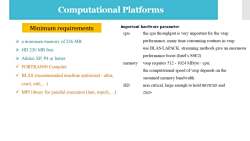
Computational Platforms Minimum requirements important hardware parameter cpu the cpu throughput is very important for the vasp >a minimum memory of 256 MB performance,many time consuming routines in vasp >HD 250 MB free use BLAS/LAPACK,streaming methods give an enormous >Athlon XP,P4 or better performance boost(Intel's SSE2) memory vasp requires 512-1024 MByte/cpu; √FORTRAN90 Compiler the computational speed of vasp depends on the BLAS (recommended machine optimized-atlas, sustained memory bandwidth cxml,mkl,...) HD non critical,large enough to hold WAVECAR and MPI library for parallel execution(lam,mpich,...) CHG*
Computational Platforms Minimum requirements ➢ a minimum memory of 256 MB ➢ HD 250 MB free ➢ Athlon XP, P4 or better ✓ FORTRAN90 Compiler ✓ BLAS (recommended machine optimized - atlas, cxml, mkl,…) ✓ MPI library for parallel execution (lam, mpich,…)
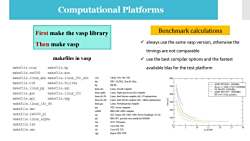
Computational Platforms First make the vasp library Benchmark calculations Then make vasp always use the same vasp version,otherwise the timings are not comparable makefiles in vasp use the best compiler options and the fastest makefile.cray makefile.hp available blas for the test platform makefile.rs6000 makefile.sun makefile.linux abs makefile.linux ifc_ath cray CRAY C9O.J90.T90 600 makefile.t3d makefile.fujitsu dec DEC ALPHA True 64 Unix HP PA AMD XP1800+100MBit 500 makefile.linux_pg makefile.sgi Xeon 2.2 GHz i7500 1000MBi limix_abs Limx,Absoft compiter P4 P4GSX 1000MBit makefile.gen makefile.linux ifc limrx alpha Limx,Alpha processors fort compiler AMD XP1700+1000MBir 400 HPes451 Ghz quad山ics linrx ifc.P4 Linurx.Intel fortran compiler(ifc),P4 optimisation makefile.sp2 makefile.vpp limrx ifc.ath Limux.Intel fortran compiler(ifc).Athlon optimisation makefile.linux ifc p4 limx_pg Limx.Portland group compiler 首0 makefile.dec nec NEC vector computer Is6000 IBM AIX xl0 compiler 200 makefile.rs6000 pl sgi SGI Origin 200/2000/3000.Power Challenge.2ete. makefile.linux alpha sp2 IBM SP2,possibly also useful for RS6000 100 sun makefile.t3e SUN,Ultrasparc 13d Cray/SGI T3D 10 15 20 25 makefile.nec Be Cray/SGI T3E of CPU p fujitsu VPP,VPX
Computational Platforms makefiles in vasp First make the vasp library Then make vasp Benchmark calculations ✓ always use the same vasp version, otherwise the timings are not comparable ✓ use the best compiler options and the fastest available blas for the test platform

Computational Platforms 的 INCAR h%少 POSCAR fcc Si: OUTCAR 3.9|tc first part:reading INCAR,POTCAR,POSCAR PREC Normal standard precision Dri,(Hiom 0.50.50.0 ENMAX 400 1 cutoff should be set manually 0.00.50.5 enearest neighbor distances and analysis of symmetry ISMEAR=0;SIGMA 0.1 ①50.00.5 information on what was parsed from INCAR IBRION =1 use DIIS algorithm to converge atoms verbose job information NFREE =2 2 independent degrees of freedom cartesian NSW 10 !10 ionic steps information on lattice,k-points and positions 000 EDIFFG =-0.02 forces smaller 0.02 A/ev information on the basis set(number of plane waves) non local pseudopotential information KPOINTS POTCAR information for each electronic step (one line in OSZICAR) CONTCAR OSZICAR CHGCAR K-Points Si PAW_PBE Si 05Jan2001 Si:s2p2, ENMAX=245.345: 0 DOSCAR PROCAR WAVECAR EAUG=322.069 Monkhorst Pack 8 band 3 energy 549527#0Ce,2.00000000 111111 ×I×I PY pz dxy dyz dz2 dxz 2 tot 000 con tr .60.0000.0000.0000.000.00 0.546 20.0000.1570.0000.0000.0000.0000.0000.0000.000 0.157 tot0.0000.7030.0000.0000.0000.0000.0000.0000.000 Q.703
Computational Platforms INCAR OUTCAR KPOINTS POSCAR POTCAR DOSCAR CHGCAR PROCAR CONTCAR OSZICAR WAVECAR
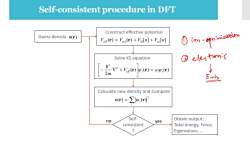
Self-consistent procedure in DFT Construct effective potential Guess density n(r) Ver (r)=Vest (r)+Vu[n]+Vse[n] 0imtniatn Solve KS equation @(hm( v.rtb.m-. Calculate new density and Compare r)=∑w,r) no Self- yes Obtain output: consistent Total energy,Force, ? Eigenvalues,…
Self-consistent procedure in DFT
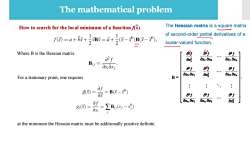
The mathematical problem How to search for the local minimum of a function f) The Hessian matrix is a square matrix of second-order partial derivatives of a f阀=a+脉+2B数=a+民-B民-。 scalar-valued function. Where B is the Hessian matrix 5 80f1 of 8r好 8r18r2 821 82n Bj Oxioxj 80f 8 80f 0r202x1 For a stationary point,one requires B= 8r好 8r20n g(= af 0派 =B(-) of of f 8xn 8x1 8zn Ox2 Bui g()= at the minimum the Hessian matrix must be additionally positive definite
The mathematical problem How to search for the local minimum of a function f(x) at the minimum the Hessian matrix must be additionally positive definite. B The Hessian matrix is a square matrix of second-order partial derivatives of a scalar-valued function. Where B is the Hessian matrix For a stationary point, one requires

Ionic relaxation Steepest descent 1.initial guess 最速下降法 初始点 J6,0)。 2.calculate the gradient g( 3.make a step into the direction of the steepest descent 2=-1/Tmax(B)g() 最小值 4.repeat step 2 and 3 until convergence is reached for functions with long steep valleys convergence can be very slow max min
Ionic relaxation 最速下降法
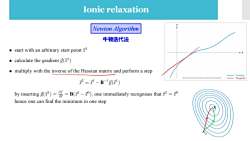
Ionic relaxation Newton Algorithm 牛顿迭代法 .start with an arbitrary start point .calculate the gradient g() multiply with the inverse of the Hessian matrix and perform a step 十 2=-B1() by inserting g()=B(),one immediately recognises that hence one can find the minimum in one step 0
Ionic relaxation 牛顿迭代法 Newton Algorithm
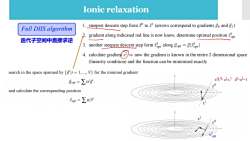
Ionic relaxation Full DIIS algorithm 1. steepest descent step from to(arrows correspond to gradients go andg) 2. gradient along indicated red line is now know.determine optimal position 迭代子空间中直接求逆 3. another steepest descent step formalong gopt=g() 4. caluateradinnowthe radient isknown in the entiredimensional space (linearity condition)and the function can be minimised exactly search in the space spanned by {gi=1,...,N}for the minimal gradient gpt=∑cdg. ak9 ax.I a+al=1 0 and calculate the corresponding position opt=∑c't 0 opt
Ionic relaxation 迭代子空间中直接求逆
按次数下载不扣除下载券;
注册用户24小时内重复下载只扣除一次;
顺序:VIP每日次数-->可用次数-->下载券;
- 电子科技大学:《材料设计与计算 Materials Design and Computation》课程教学资源(课件讲稿)MDC 03 DFT(2/3).pdf
- 电子科技大学:《材料设计与计算 Materials Design and Computation》课程教学资源(课件讲稿)MDC 02 DFT(1/3).pdf
- 电子科技大学:《材料设计与计算 Materials Design and Computation》课程教学资源(课件讲稿)MDC 01 Introduction(张妍宁).pdf
- 《材料设计与计算 Materials Design and Computation》课程教学资源(参考书籍)DENSITY FUNCTIONAL THEORY - A Practical Introduction(DAVID S. SHOLL、JANICE A. STECKEL).pdf
- 电子科技大学:《材料分子结构分析 Molecular Structure Analysis of Materials》课程教学资源(课件讲稿)第九章 热分析 Thermal analysis.pdf
- 电子科技大学:《材料分子结构分析 Molecular Structure Analysis of Materials》课程教学资源(课件讲稿)第八章 色谱法 chromatography.pdf
- 电子科技大学:《材料分子结构分析 Molecular Structure Analysis of Materials》课程教学资源(课件讲稿)第七章 核磁共振谱 Nuclear Magnetic Resonance Spectroscopy,NMR.pdf
- 电子科技大学:《材料分子结构分析 Molecular Structure Analysis of Materials》课程教学资源(课件讲稿)第六章 拉曼光谱 Raman spectroscopy.pdf
- 电子科技大学:《材料分子结构分析 Molecular Structure Analysis of Materials》课程教学资源(课件讲稿)第五章 红外光谱 Infrared Spectroscopy.pdf
- 电子科技大学:《材料分子结构分析 Molecular Structure Analysis of Materials》课程教学资源(课件讲稿)第四章 分子荧光光谱 Molecular fluorescence spectroscopy.pdf
- 电子科技大学:《材料分子结构分析 Molecular Structure Analysis of Materials》课程教学资源(课件讲稿)第三章 紫外——可见光谱 Ultraviolet and visible spectroscopy UV—Vis.pdf
- 电子科技大学:《材料分子结构分析 Molecular Structure Analysis of Materials》课程教学资源(课件讲稿)第二章 波谱分析.pdf
- 电子科技大学:《材料分子结构分析 Molecular Structure Analysis of Materials》课程教学资源(课件讲稿)第一章 绪论(刘钰).pdf
- 电子科技大学:《薄膜材料与技术 Thin Film Material and Technology》课程教学资源(课件讲稿)第四章 金属薄膜的电导.pdf
- 电子科技大学:《薄膜材料与技术 Thin Film Material and Technology》课程教学资源(课件讲稿)第三章 薄膜的力学性质.pdf
- 电子科技大学:《薄膜材料与技术 Thin Film Material and Technology》课程教学资源(课件讲稿)第二章 真空技术.pdf
- 电子科技大学:《薄膜材料与技术 Thin Film Material and Technology》课程教学资源(课件讲稿)第一章 绪论(授课老师:白飞明).pdf
- 电子科技大学:《电子材料》课程教学资源(教学大纲).doc
- 上海交通大学:《材料科学与工程前沿》课程教学资源(案例讲座)石墨烯及其应用.pdf
- 上海交通大学:《材料科学与工程前沿》课程教学资源(案例讲座)汽车轻量化制造对材料及材料加工技术的挑战.pdf
- 电子科技大学:《材料设计与计算 Materials Design and Computation》课程教学资源(课件讲稿)MDC 05 Bulk calculations(1/2).pdf
- 电子科技大学:《材料设计与计算 Materials Design and Computation》课程教学资源(课件讲稿)MDC 06 Bulk calculations(2/2).pdf
- 电子科技大学:《材料设计与计算 Materials Design and Computation》课程教学资源(课件讲稿)MDC 07 Surface calculations(1/2).pdf
- 电子科技大学:《材料设计与计算 Materials Design and Computation》课程教学资源(课件讲稿)MDC 11 Modeling, Computation, Simulation, Designing and Screening of New Materials.pdf
- 电子科技大学:《材料设计与计算 Materials Design and Computation》课程教学资源(课件讲稿)MDC 12 An introduction of Monte Carlo method.pdf
- 电子科技大学:《材料设计与计算 Materials Design and Computation》课程教学资源(课件讲稿)MDC 13 Monte Carlo.pdf
- 电子科技大学:《材料设计与计算 Materials Design and Computation》课程教学资源(课件讲稿)MDC 14 Modeling and Simulation in Epitaxial Growth.pdf
- 电子科技大学:《材料设计与计算 Materials Design and Computation》课程教学资源(课件讲稿)MDC 15 Examples of MCMC:Reaction-Diffusion(R-D)model.pdf
- 电子科技大学:《材料设计与计算 Materials Design and Computation》课程教学资源(课件讲稿)MDC 16 MD in Materials Studio Key Modules.pdf
- 电子科技大学:《材料设计与计算 Materials Design and Computation》课程教学资源(课件讲稿)MDC 08 Surface calculations(2/2).pdf
- 电子科技大学:《材料设计与计算 Materials Design and Computation》课程教学资源(课件讲稿)MDC 09 Materials design.pdf
- 《金陵科技学院学报》:PZT压电材料参数在ANSYS中的定义方法.pdf
- 佛山大学(佛山科学技术学院):《高分子材料加工实验》课程教学资源(参考资料,打印版)塑料、纤维、橡胶的英文缩写语.pdf
- 佛山大学(佛山科学技术学院):《高分子材料加工实验》课程教学资源(实验,打印版)高分子材料配方实例.pdf
- 佛山大学(佛山科学技术学院):《高分子材料加工实验》课程教学资源(实验,打印版)实验三十一 一种隔热涂料的制备及其性能测试实验.pdf
- 佛山大学(佛山科学技术学院):《高分子材料加工实验》课程教学资源(实验,打印版)实验三十 高分子材料3D打印实验.pdf
- 佛山大学(佛山科学技术学院):《高分子材料加工实验》课程教学资源(实验,打印版)实验二十九 硬脂酸相变储能石膏板的制备与性能研究.pdf
- 佛山大学(佛山科学技术学院):《高分子材料加工实验》课程教学资源(实验,打印版)实验十六 扫描电子显微镜法观察聚合物聚态结构.pdf
- 佛山大学(佛山科学技术学院):《高分子材料加工实验》课程教学资源(实验,打印版)实验十五 差热分析.pdf
- 佛山大学(佛山科学技术学院):《高分子材料加工实验》课程教学资源(实验,打印版)实验十四 红外光谱分析.pdf
